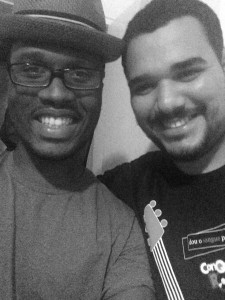May 13, 2015- Salvador, Bahia, Brazil
Boa noite, readers! Meu nom Roman! At the time of this post, it is late at night and I am retiring from today’s adventures full of new sites and experiences. I am so happy. Today has been a truly transforming experience visiting Pelourinho because so much of Africa’s history is literally in the landscape. (The picture that you see below is one of myself in Pelourinho.)
It is a historical fact that Africans built the golden Catholic churches which line the streets of Salvador. Jorge Amado, one of Salvador’s most famous members and a prominent writer, once wrote of Salvador’s breathtaking beauty. But Salvador’s beauty is not something one can capture in a book: it is truly transcendent of time and space. The city’s people are multiracial and mostly the descendants of those who performed slave labor here harvesting tobacco, sugarcane, and cotton. Most of the crops were introduced here by the Europeans were harvested as commercial goods. Although Brazil is multiracial, Salvador has a distinctly black, or African, essence.
Blackness is found in the way the men strut with a handsome gait and in how Afro-Brazilian women model their afros with such beautiful grace and style. The people are gorgeous!
Brazil–the city of Salvador in particular– is black in the respect that is connected to traditional African spiritual practices. Candomble is closely connected to the Ifa Vodun tradition of Nigeria, Benin, and Togo. This religion’s deities came from the religion Ifa and include Ochala (Obatala), Oxum (Oxum), Chango (Shango), and Oxosi (Ochosi). Today, I was re-introduced to this information by our tour guide for the Pelhourinho visit, Fred. Spirituality is a celebrated thing here!
I am happy to have so many adopted family members now. My brother Nito returned home today. One of my brothers, Igor, (who is actually a leasee of my host mother), is also pictured below on the right with myself.
I’m having a blast every day!
Tchau tchau,
Roman


